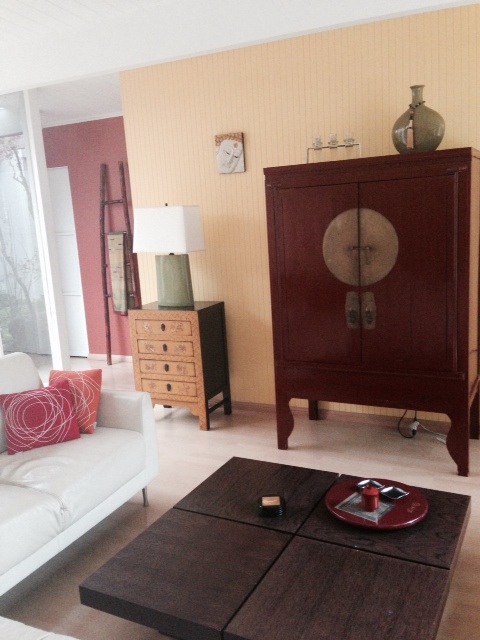Making Antiques Work in a Mid-Century Modern Home
 |
|
|
For fans of the mid-century modern look, which includes all of us here at the Eichler Network, it can sometimes be hard to look outside the classic genres of mid-century design when we go to decorate. Sometimes we'll dip into deco and sometimes we have an heirloom from another era, but more often we're hitting up the flea markets and second-hand stores, looking for just that perfect retro-futurist piece from 1963.
However, an article in the Kansas City Star suggested we might be doing it wrong. Certain antiques from China, it asserted, tend to work surprisingly well with the MCM look. These are pieces built in the late 19th and early 20th centuries, often refinished in the mid-20th century, antiques dealer Tim Butt told The Star:
"Most cabinets and tables, he notes, were originally painted in red or black, but during the 1940s and ’50s, the Chinese would often strip and repaint the pieces in brighter colors such as yellow, turquoise, chartreuse, and even pink to help make their environment less oppressive."
I wanted to hear what some of our Eichler Network designers thought about this notion, and to learn what other antiques, if any, they thought might work well in an Eichler or other MCM home.
"Personally, I really like Asian-influenced furniture and art in modern homes. The furniture reflects the character of the interior space. Also, Joe Eichler was influenced by Frank Lloyd Wright, and Wright was influenced by Japanese architecture," says Yujin Jeon, of Jeon Design.
Jeon, who is originally from Korea and designed one of the finalists in our kitchen makeover challenge, said she most often uses Japanese or Korean pieces when decorating Eichlers. The Japanese "have a floor-sitting culture, which works well with the radiant heating" in an Eichler, she said. The openness and simplicity in much Japanese design, including antiques, makes it an elegant complement to Eichlers.
But, Jeon said, "The Chinese have a very nice vibrant accent artwork, which is very beautiful. I've used that many times." The key, when using something bold, like a brightly colored Chinese antique, is to keep the rest of the room as simple and minimal as possible.
That mix can be very attractive when done right, said Lucile Glessner, of Lucile Glessner Design. "I'm originally from France, and there we mix contemporary with antique all he time. Many of the buildings are very old, so it's easy to mix several perspectives," Glessner said. Doing so, she added, gives an old building a more contemporary feel, and in reverse can give a modern building a warmer feel.
"You put an antique piece on a wall of color, for instance, and it gives a more eclectic style and adds warmth and color. Especially if you're using a Chinese piece, much more than a Japanese one. I think the lines work very well, because even though it's an antique piece, they have very clean lines."
In fact, Glessner said, antiques from all over East and South Asia can work very well if they're presented right. "I think you have to find a unique piece and mix it. It can be ornate as well, as long as it's only one. So long as you don't have a lot of very eclectic pieces everywhere, you can have one or two in each room. It can add color, or texture, and it can create a very organic feel to the space."
Guess it's time to take a trans-Pacific trip, or at least a drive to the antique store.
- ‹ previous
- 393 of 677
- next ›




